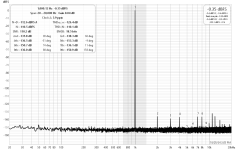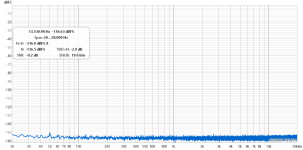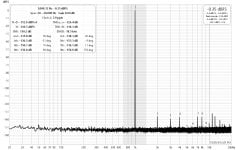Hi everyone
We are releasing our new flagship monoblock at the Australian HiFi Show in a few weeks time. Just thought I would share a little test data.
Below is a plot of the P801 running at 5 watts as you would typically see on sites such as ASR. Distortion levels beat anything I have seen.
The SINAD (THD+N) is noise dominated. We cant actually measure an accurate SINAD figure because our measurement signal source, although very good, is too noisy! In reality the noise floor, and SINAD is around -115dB to -116dB.
Please note that our new "ultra buffer" is designed to provide overall gain options of 23dB or 29dB. Here we are set at 23dB. This gain level is required to make the amp hit full rated power output into 4 ohms with a standard balanced XLR 4 volt rms input signal. 29dB is required when using a 2 volt RCA source.
Just be aware/wary when comparing SINAD figures that some manufacturers rely on very low gain levels to obtain their results. This is using the basis that lower gain equals lower noise and therefore higher SINAD. Often they just use the power amp module gain (13dB) where you would require an input signal of 10 volts or more to drive the power amp to full output.
Very few domestic signal sources can do this, particularly with suitably low noise and distortion.
To put it into context, a typical DAC or streamer with 4 volt XLR output would only drive this amp with a 13dB gain setting to 80 watts output into 4 ohms. Only 20 watts with a 2 volts RCA source.

We are releasing our new flagship monoblock at the Australian HiFi Show in a few weeks time. Just thought I would share a little test data.
Below is a plot of the P801 running at 5 watts as you would typically see on sites such as ASR. Distortion levels beat anything I have seen.
The SINAD (THD+N) is noise dominated. We cant actually measure an accurate SINAD figure because our measurement signal source, although very good, is too noisy! In reality the noise floor, and SINAD is around -115dB to -116dB.
Please note that our new "ultra buffer" is designed to provide overall gain options of 23dB or 29dB. Here we are set at 23dB. This gain level is required to make the amp hit full rated power output into 4 ohms with a standard balanced XLR 4 volt rms input signal. 29dB is required when using a 2 volt RCA source.
Just be aware/wary when comparing SINAD figures that some manufacturers rely on very low gain levels to obtain their results. This is using the basis that lower gain equals lower noise and therefore higher SINAD. Often they just use the power amp module gain (13dB) where you would require an input signal of 10 volts or more to drive the power amp to full output.
Very few domestic signal sources can do this, particularly with suitably low noise and distortion.
To put it into context, a typical DAC or streamer with 4 volt XLR output would only drive this amp with a 13dB gain setting to 80 watts output into 4 ohms. Only 20 watts with a 2 volts RCA source.

Last edited:


